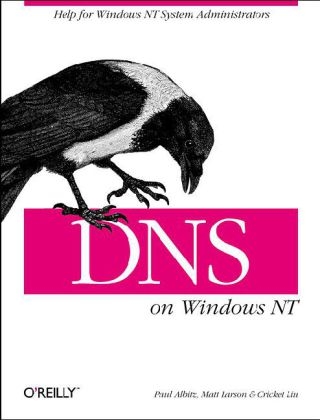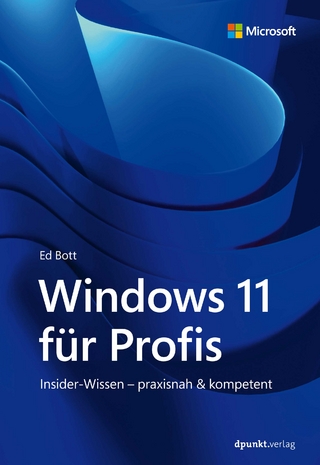
DNS on Windows NT
O'Reilly Media (Verlag)
978-1-56592-511-3 (ISBN)
- Titel ist leider vergriffen;
keine Neuauflage - Artikel merken
DNS on Windows NT is a special edition of the classic DNS and BIND, which Microsoft recommends for Windows NT users and administrators. It discusses one of the Internet's fundamental building blocks: the distributed host information database that's responsible for translating names into addresses, routing mail to its proper destination, and many other services. As the authors write in the preface, if you're using the Internet, you're already using DNS -- even if you don't know it. This book covers the DNS server in Windows NT 4.0, as updated with Service Pack 3. In addition to covering general issues, like installing, setting up, and maintaining the server, it covers many issues specific to the Windows environment: integration between DNS and WINS, converting from BIND to the Microsoft DNS server, and registry settings. It pays special attention to security issues, system tuning, caching, and zone change notification. It also pays detailed attention to issues like troubleshooting and planning for growth.
Whether you're an administrator involved with DNS on a daily basis, or a user who wants to be more informed about the Internet and how it works, you'll find that this book is essential reading. Topics include: What DNS does, how it works, and when you need to use it How to find your own place in the Internet's name space Setting up name servers Using MX records to route mail Configuring hosts to use DNS name servers Subdividing domains (parenting) Securing your name server: preventing unauthorized zone transfers Mapping one name to several servers for load sharing Troubleshooting: using nslookup, diagnosing common problems
Paul Albitz is a software engineer at Hewlett-Packard. Paul earned a bachelor of science degree from the University of Wisconsin, LaCrosse, and a master of science degree from Purdue University. Paul worked on BIND for the HP-UX 7.0 and 8.0 releases. During this time Paul developed the tools used to run the hp.com domain. More recently, he has been involved in networking HP's DesignJet plotter. Before joining HP, Paul was a system administrator in the CS Department of Purdue University. As system administrator, Paul ran versions of BIND before BIND's initial release with 4.3 BSD. Paul and his wife Katherine live in San Diego, CA. Matt Larson started Acme Byte & Wire, a company specializing in DNS consulting and training, with Cricket Liu in January 1997. Previously, he worked for Hewlett-Packard, first as Cricket's successor as hp.com hostmaster, then as a consultant in HP's Professional Services Organization. Matt graduated from Northwestern University in 1992 with two degrees: a bachelor of arts in computer science and a bachelor of music in church music/organ performance. He lives in Bethesda, Maryland, with his wife, Sonja Kahler, and their two pugs. In his spare time he enjoys playing the 10-rank pipe organ in his house and flying light airplanes. Cricket Liu matriculated at the University of California's Berkeley campus, that great bastion of free speech, unencumbered UNIX, and cheap pizza. He went to work for Hewlett-Packard Company after graduation and stayed at HP for nine years. Cricket began managing the hp.com zone after the Loma Prieta earthquake forcibly moved the zone's management from HP Labs to HP's Corporate Offices. He was hostmaster@hp.com for over three years, and then joined HP's Professional Services Organization to found HP's Internet consulting program. Cricket currently runs his own DNS consulting and training company, Acme Byte & Wire, with his friend Matt Larson. Cricket, his wife Paige, and their son Walt, live in Colorado with two Siberian Huskies, Annie and Dakota. On warm weekends, you'll probably find them on the flying trapeze.
Preface 1. Background A (Very) Brief History of the Internet On the Internet and Internets The History of the Domain Name System The Domain Name System, in a Nutshell The History of the Microsoft DNS Server. 2. How Does DNS Work? The Domain Name Space The Internet Domain Name Space Delegation Name Servers and Zones Resolvers Resolution Caching. 3. Where Do I Start? Which DNS Server? Getting the DNS Server Choosing a Domain Name. 4. Setting Up the Microsoft DNS Server Our Domain DNS Manager Setting Up DNS Data Running a Primary Master Name Server Running a Slave Name Server Adding More Domains DNS > Properties What Next? 5. DNS and Electronic Mail MX Records Adding MX Records with DNS Manager What's a Mail Exchanger, Again? The MX Algorithm 6. Configuring Hosts The Resolver Sample Resolver Configurations Other Naming Services Differences in Service Behavior. 7. Maintaining the Microsoft DNS Server What About Signals? Updating Zone Data Zone Database File Controls Keeping Everything Running Smoothly. 8. Growing Your Domain How Many Name Servers? Adding More Name Servers Registering Name Servers Changing TTLs Planning for Disasters Coping with Disaster. 9. Parenting When to Become a Parent How Many Children? What to Name Your Children How to Become a Parent: Creating Subdomains Subdomains of in-addr.arpa Domains Good Parenting Managing the Transition to Subdomains The Life of a Parent. 10. Advanced Features and Security DNS NOTIFY (Zone Change Notification) WINS Linkage System Tuning Name Server Address Sorting Building Up a Large Sitewide Cache with Forwarders A More Restricted Name Server A Nonrecursive Name Server Securing Your Name Server Load Sharing Between Mirrored Servers 11. nslookup Is nslookup a Good Tool? Interactive versus Noninteractive Option Settings Avoiding the Search List Common Tasks Less Common Tasks Troubleshooting nslookup Problems Best of the Net. 12. Troubleshooting DNS Is DNS Really Your Problem? Checking the Cache Potential Problem List Interoperability Problems Problem Symptoms. 13. Miscellaneous Using CNAME Records Wildcards A Limitation of MX Records DNS and Internet Firewalls Dialup Connections Network Names and Numbers DNS versus X.500 A. DNS Message Format and Resource Records B. Installing the DNS Server from CD-ROM C. Converting from BIND to the Microsoft DNS Server D. Top-Level Domains E. Domain Registration Form F. in-addr.arpa Registration Form G. Microsoft DNS Server Registry Settings Index
| Erscheint lt. Verlag | 10.11.1998 |
|---|---|
| Zusatzinfo | index |
| Verlagsort | Sebastopol |
| Sprache | englisch |
| Maße | 178 x 233 mm |
| Gewicht | 330 g |
| Einbandart | kartoniert |
| Themenwelt | Informatik ► Betriebssysteme / Server ► Windows |
| Informatik ► Betriebssysteme / Server ► Windows Server | |
| Mathematik / Informatik ► Informatik ► Netzwerke | |
| ISBN-10 | 1-56592-511-4 / 1565925114 |
| ISBN-13 | 978-1-56592-511-3 / 9781565925113 |
| Zustand | Neuware |
| Haben Sie eine Frage zum Produkt? |
aus dem Bereich


